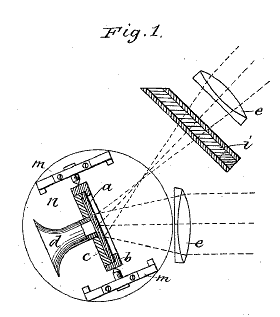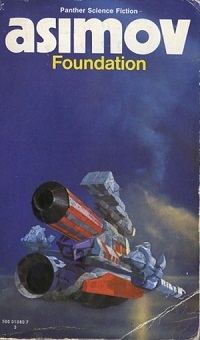In today’s installment of Science of Future Past, we continue our exploration of the technology showcased in the forth part of Asimov’s Foundation: The Traders.
As we discussed in the last episode, in part four of Foundation, The Traders, a space-faring trader by the name of Linmar Ponyets is ordered by the Foundation to go and rescue a fellow trader who has been imprisoned by a hostile government. Last time we focused on the possible technology behind the message capsule that contained Ponyets’ orders. Today we’ll take a look at the science behind two pieces of technology that receive only casual mentions in the book: spy beams and field distorters.
From the Text:
“Be careful,” said Gorov, tautly. “There’ll be someone listening. Are you wearing a Field Distorter?” Ponyets indicated the ornamented bracelet that hugged his wrist and Gorov relaxed.
While we aren’t told exactly what this field distorter does, we can pretty easily infer that it interferes with eavesdropping devices. A similar device is used in the first part of Foundation when Gaal is meeting with Hari Seldon’s lawyer:
Avakim, paying no attention to Gaal’s outburst, finally looked up. He said, “The Commission will, of course, have a spy beam on our conversation. This is against the law, but they will use one nevertheless.”
Gaal ground his teeth.
“However,” and Avakim seated himself deliberately, “the recorder I have on the table,—which is a perfectly ordinary recorder to all appearances and performs it duties well—has the additional property of completely blanketing the spy beam. This is something they will not find out at once.”
The Photophone
Before we can investigate the field distorter and blanketing devices, let’s take a look at the possible technology behind the spy beam.
Way back in 1880, Alexander Graham Bell filed a patent for what he called his “greatest achievement”, an apparatus used to transmit human speech over light waves called the photophone.

If you examine figure 1 from a patent application for the transmitter, you can see how it works. Sunlight travels through a focusing lens (e), passes through a heat-absorption layer (i), strikes a thin, reflective material (a) and is reflected out through another lens (e). The person sending the message speaks into the mouthpiece (d) and the sound waves from their voice causes the reflector (a) to vibrate, which causes distortions in the reflected light.
On the receiving end, an electrical circuit was created which consisted of a power source, a substance whose electrical resistance varied when exposed to light, and a telephone receiver. As the light from the transmitter strikes the substance, the variations in the light beam cause variations in its resistance. These variations result in a variation of current passing through the telephone receiver, which uses the variations to generate sound.
While the photophone itself never saw widespread success due to its technical limitations, the technology behind the invention influenced other inventions such as fiber-optic communication, wireless signaling, the laser, and most importantly for today’s discussion, the laser microphone.
The Laser Microphone
The laser microphone is a sort of reverse-photophone. A laser beam strikes a glass window and is reflected back to a receiver. People speaking in the room cause the window glass to vibrate, which causes distortions in the beam. The receiver converts those distortions into sound waves.
While this would have been relatively hi-tech stuff in Asimov’s time, nowadays you can find instructions for building your very own laser microphone spy kit for less than $20. The CIA reportedly used a laser microphone to help them pinpoint the location of Osama Bin Laden. Though I imagine they used something more sophisticated than the $20 version.
Field Distortion
So now that we understand how such devices work, we can move on to how one might prevent them from being used. The first thing you should know is that conditions have to pretty ideal for a laser microphone to work in the first place. According to tests and analysis done by Kevin Murray’s SpyBusters, laser microphones can easily be thwarted by such low-tech things as curtains, thermo-pane glass, or even a good rainstorm.
He points out, however, that recent research has developed a technique for using a more advanced style of laser-microphone. From the paper:
“The principle is to observe the movement of the secondary speckle patterns that are generated on top of the target when it is illuminated by a spot of laser beam. Proper adaption of the imaging optics allows following the temporal trajectories of those speckles and extracting the sound signals out of the processed trajectory.”
In other words, by shining a laser on an object, then taking a blurred video of that object, the patterns in the blurriness can be used to deduce the movement of that object and vibrations caused by that object, including those related to speech and even heartbeat.
While this technique seems to result in much better speech analysis and circumvents many of the problems encountered by traditional laser microphones, it’s reliance on visible recording means it could easily be thwarted by any apparatus that prevents visual surveillance, such as a curtain or a nice pair of anti-paparazzi glasses.
Conclusion
Most likely the advanced civilizations of Foundation used something even more sophisticated than photophones and laser cameras. However the principles are likely the same, use some type of radiation that can detect distortions caused by sound waves. Likewise, the field distorter merely has to interfere with the detection ray, or mask the signal sufficiently to make the ray useless.
For homework this week, amaze your friends by building your very own laser-microphone or visual field distorter.
Dr. Lee Falin is a Bioinformatician at the European Bioinformatics Institute the host of the Everyday Einstein’s Quick and Dirty Tips podcast and the author of the “Science Fictioned” series, in which he takes scientific research articles and turns them into science fiction and fantasy short stories for middle grade and young adult readers.










